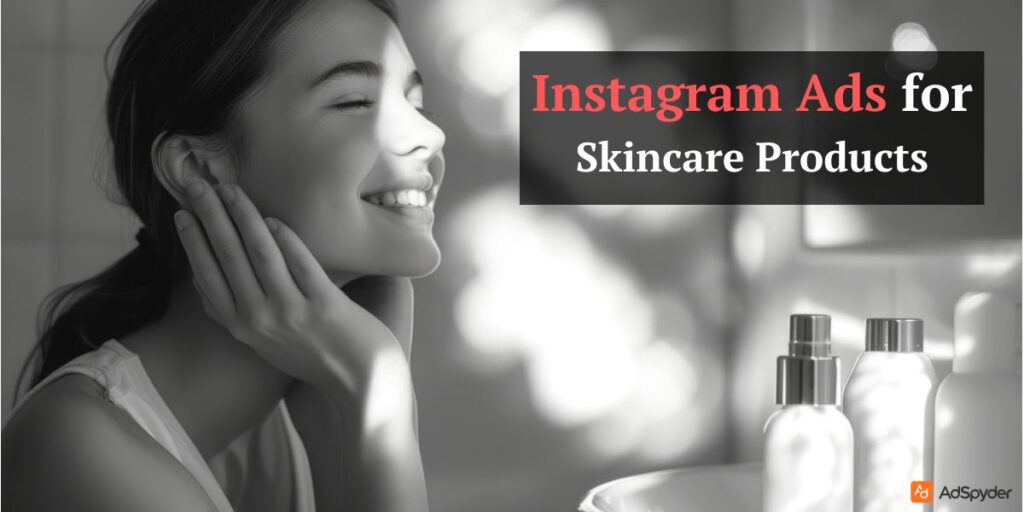Instagram has emerged as one of the most effective channels for beauty firms to promote their goods, and the skincare sector is expanding. With more than 2 billion active users, Instagram offers a special chance to connect with highly engaged audiences interested in skincare, self-care, and beauty. Instagram ads for skincare products firms trying to draw in, interact with, and win over new customers because of its visual storytelling, influencer culture, and shopping capabilities. Instagram advertisements may help you raise exposure, improve interaction, and increase sales, whether you’re starting a new skincare line or growing an existing business.
Ready to Elevate your Marketing Strategy?
This blog will walk you through audience targeting, ad formats, creative techniques, and best practices to help you get the most out of your Instagram ads for skincare products.
Why Skincare Brands Should Use Instagram Ads
Instagram is more than just another social media site; it’s a visual marketplace where skincare enthusiasts actively look for tutorials, product recommendations, and professional guidance. Here are some reasons why skincare companies ought to spend money on Instagram marketing:
1. Highly Visual Platform for Showcasing Skincare
Instagram is ideal for skincare firms to exhibit because it thrives on high-quality photographs and videos, unlike platforms that rely heavily on text:
- Product textures (serums, creams, face masks, cleansers).
- Transformations from before and after to demonstrate the efficacy of skincare.
- Detailed skincare instructions to inform prospective buyers.
- Explanations of the benefits and special compositions of the ingredients.
Check Out: High-Converting Beauty Product Ads
2. Precision Audience Targeting
Skincare brands may target particular demographics, interests, and behaviors with Instagram Ads. Instagram’s targeting tools guarantee that your ads are seen by the appropriate people at the right time, regardless of whether your ideal client is a kid with acne issues or a high-end skincare buyer searching for anti-aging products.
3. Shoppable Features for Seamless Purchases
Skincare firms may now sell products directly through their advertisements, thanks to Instagram’s integration of Instagram Shopping, product tags, and direct checkout options.
- Without ever leaving Instagram, users may buy products by tapping on them in advertisements.
- Brands may link straight to their store with Shoppable Reels & Stories.
- A full skincare regimen can be shown in a single advertisement using product carousels.
4. Leverage Influencer & UGC (User-Generated Content) Marketing
Because Instagram’s culture is based on social evidence, skincare firms may use it to:
- Collaborate with experts and beauty influencers to establish credibility.
- Advertise with actual client testimonials and skincare outcomes.
- Encourage people to utilise branded hashtags while sharing their skincare makeovers.
Skincare companies may greatly raise brand awareness and conversions by utilising Instagram’s ad features, audience targeting, and social commerce tools.
Best Instagram Ads for Skincare Products

Instagram provides skincare firms with a range of ad styles to interact with various audience demographics. Your campaign’s objectives—brand exposure, engagement, website traffic, or sales—will determine which ad style is best.
1. Photo Ads – Simple Yet Effective
Instagram For skincare firms who want to highlight product packaging, texture, or essential ingredients with simple, minimalistic images, photo ads are ideal.
Best Practices for Skincare Photo Ads:
- Use high-resolution, visually appealing, aesthetically pleasing images.
- Make the background as plain as you can to help the product stand out.
- Include succinct, captivating descriptions that highlight the advantages of skincare.
- Emphasise components that set your product apart, such as “Powered by Hyaluronic Acid for Deep Hydration”.
Example: A skincare firm advertising an entirely novel vitamin C serum could utilise an illustration ad that draws attention to the product’s natural ingredients and brightening properties by exhibiting the bottle with an orange backdrop.
2. Carousel Ads – Show Multiple Skincare Products or Steps
Carousel Ads allow skincare brands to display multiple images or videos in one ad, making them perfect for:
- Skincare regimens that are detailed, such as “Morning Routine: Cleanse → Hydrate → Protect”.
- Skincare results before and after to demonstrate the efficacy of the product.
- Showcasing various skincare items in an assortment.
Top Practices for Skincare Carousel Ads:
- Make sure your branding is the same on every slide.
- Tell a tale (e.g., start by describing a skin issue and demonstrate how your product resolves it).
- Use clear calls-to-action (CTA) like “Swipe to Learn More” or “Tap to Shop.”
Example: A carousel advertisement that shows pictures of a cleanser, toner, serum, and moisturiser and explains how each phase functions may be used by a company that sells a complete skincare regimen.
3. Video Ads & Reels Ads – Engage with Motion
For skincare firms wishing to illustrate the use and efficacy of their products, video material is perfect because it outperforms still photos.
Best Types of Video Ads for Skincare:
- Tutorials – Step-by-step instructions for using a skincare product.
- Time-lapse transformations – Showing improvements in the skin over a period of days or weeks.
- Influencers or skilled specialists describing the advantages of skincare.
- ASMR skincare videos – Skincare sounds of foam cleansers, serum drops, or facial massage techniques up close.
Best Practices for Skincare Video Ads:
- Keep it brief (less than 30 seconds for feed ads and 6–15 seconds for Instagram reel ads).
- Add text overlays for people who watch without sound.
- Include close-ups of actual skin results, textures, and application.
- Finish with a compelling call to action (e.g., “Shop Now” or “Try It Today”).
Example: A company marketing a moisturising face mask could make a 6-second Instagram Reels advertisement that featured a model putting the mask on, waiting ten minutes, and then displaying radiant skin.
4. Instagram Stories Ads – Full-Screen & Interactive
Instagram Stories Ads create a full-screen, immersive experience by popping up in between users’ Stories.
Why Stories Ads Work for Skincare Brands:
- They blend in perfectly with natural content and feel natural.
- They instantly engage users and are ideal for mobile devices.
- They permit interactive elements like product tags, swipe-ups, and polls.
Top Practices for Instagram Stories Ads:
- Stories fade rapidly, so make sure your wording is crisp and your images are bold.
- Feature a model using the skincare product to create a lifestyle connection.
- Add CTAs that say “Swipe Up” or “Shop Now” to increase conversions right away.
Example: A sunscreen brand company would show an Instagram Story Ad featuring a beach scene with a user applying sunscreen, followed by a text overlay: “Swipe Up to Protect Your Skin”.
Must See: Beauty Brand Advertising Strategies
5. Collection Ads – Seamless Shopping Experience
Collection ads are perfect for skincare firms with several product lines since they blend product catalogs with videos.
Best Uses for Collection Ads in Skincare:
- Advertise a complete skincare line (e.g., “Hydration Essentials Kit”).
- Display the results of a skincare quiz along with suggested purchases.
- Put best-selling bundles or holiday gift packages on display.
Best Practices for Collection Ads:
- Make use of an attention-grabbing cover photo or video.
- Display similar skincare items together, such as moisturiser, serums, and SPF.
- Make sure items are tagged for Instagram Shopping customers to make purchases right away.
Example: A skincare firm may develop a Collection Ad featuring a “Winter Skincare Kit”, displaying a cleanser, moisturiser, and night cream with a “Shop the Collection” CTA.
Audience Targeting Strategies for Skincare Instagram Ads

When the correct demographic is reached at the right time, Instagram ads perform at their best. Instagram’s advanced targeting features can be used by skincare firms to reach out to those customers who are most likely to be interested in their offerings. Some of the best audience segmentation techniques for skincare advertisements are listed below.
1. Interest-Based Targeting – Reaching Skincare Enthusiasts
Instagram gives advertisers the ability to target users according to their preferences and actions. This feature allows skincare companies to reach consumers who:
- Browse beauty and skincare pages.
- Explore content about dermatology, wellness, and self-care.
- Engage with clean beauty, cruelty-free, or organic skincare topics.
Example: Users interested in “anti-aging skincare”, “retinol”, and “dermatologist-recommended beauty products” can be targeted by a company marketing a new anti-aging serum.
2. Demographic Targeting – Refining Your Audience
- Age: Teenagers and young adults (16–25 years old) should be the target market for skincare companies that specialise in acne treatments. They should target customers above 35 if they sell anti-aging products.
- Gender: Although the majority of skincare firms target women, there is a growing market for men’s skincare products, necessitating their own advertising efforts.
- Location: Geo-targeting is useful for local skincare clinics, dermatologists, or particular nation promotions.
Example: A high-end skincare company that sells gold-infused face creams should target high-income women aged 30-50 who engage with premium beauty content.
3. Behavior-Based Targeting – Engaging Active Shoppers
Instagram can improve ad targeting by monitoring user behavior and activity patterns.
- Target users who often purchase cosmetics online.
- Reach users who have used identical skincare products.
- Pay attention to those people who have saved or shared skincare posts.
Example: A brand of hydrating moisturiser may display advertisements to users who have recently used serums, hydrating masks, or face oils.
4. Lookalike Audiences – Expanding Your Reach
Lookalike audiences assist brands in identifying new potential customers who have similar interests and behaviors to existing buyers.
- Instagram looks for individuals who are similar to your current client base.
- Increases your audience without sacrificing relevancy, which aids in campaign scaling.
Example: A K-beauty company with a sizable following can develop a Lookalike Audience of skincare aficionados who follow Korean beauty trends.
5. Retargeting Ads – Bringing Back Interested Shoppers
Before making a purchase, a lot of skincare consumers research products, verify ingredients, and read reviews. Retargeting advertisements aid in their return.
Types of Retargeting for Skincare Brands:
- Website Visitors: Display advertisements to those who came to your website but didn’t buy anything.
- Cart Abandoners: Users that added items to their cart but did not finish the checkout process.
- Engaged Instagram Users: Reach out to those who have commented, liked, or bookmarked your skincare content.
Example: A vitamin C serum retargeting advertisement can say, “Are you still considering our Brightening Serum? Save 10% when you shop now!
Skincare brands may optimise ad performance and attract the right consumers by utilising interest-based, demographic, and behavior-based methods and retargeting methods.
Creating High-Converting Instagram Ads for Skincare Products

Targeting the right audience is only one aspect of running Instagram advertising; another is deploying advertisements that draw in, hold the attention of, and encourage viewers to become customers. Key tactics for producing effective skincare advertisements are listed below.
1. Writing Compelling Ad Copy & CTAs
Ad copy should be succinct, interesting, and benefit-oriented. It should have an effective call to action (CTA) and highlight the features that set your skincare product apart.
Best Ad Copy Practices for Skincare Brands:
- Pay attention to the advantages rather than the characteristics (“Hydrate your skin instantly with our hyaluronic acid-infused moisturiser”).
- Provide data or figures (“Clinically proven to reduce wrinkles in 2 weeks”).
- Create a sense of urgency (“Limited-time offer: 20% off today only!”).
Best call to action for Skincare Ads:
- “Shop Now”
- “Achieve Glowing Skin Right Now”
- “Try It Now—No Risk”
2. Using High-Quality Visuals & Lifestyle Imagery
Because Instagram is a visual-first platform, low-quality photos won’t do well.
Best Practices for Skincare Ad Creatives:
- To highlight the texture of your products, use natural sunlight.
- Feature close-up shots of glowing, healthy skin to emphasise the advantages of the product.
- Display actual users of the product to ensure authenticity.
- Insert a description emphasising the components, like “Packed with Aloe Vera & Vitamin E”.
3. Highlighting Key Ingredients & Benefits
The ingredients in skincare products are important to consumers nowadays.
- Emphasise any vegan, cruelty-free, or dermatologist-tested products you have.
- Mention particular components (e.g., “Infused with Retinol to boost collagen production”).
4. Incorporating Testimonials, Reviews & UGC
Authentic customer reviews are more trusted than claims made by brands.
- Display real customers’ before and after photos.
- Made use of quotes from pleased clients.
- Display skincare experts and influencers who are promoting the product.
5. Optimising Ad Placement & Format
- Use Instagram Reels and Stories to create brief, highly engaging films.
- Run Feed Ads for detailed, superior skincare images.
- Test different ad formats (single image vs. carousel vs. video) to determine what works best.
Skincare brands may greatly increase ad engagement and conversions by employing social proof, high-quality imagery, and compelling ad language.
Explore Now: Local Salon Advertising
Leveraging Influencer Marketing & UGC in Skincare Ads

Ads for skincare products gain credibility when they feature genuine customer reviews and experiences. By showcasing outcomes, influencers and user-generated content (UGC) increase engagement and credibility.
1. Collaborating with Beauty Influencers
One of the best strategies for boosting conversions and establishing credibility is influencer marketing.
- Partner with beauty bloggers, skincare specialists, and dermatologists.
- Run sponsored Reels and Stories on Instagram that show off actual product use.
- Collaborate with micro-influencers who have between 10,000 and 100,000 followers to increase authenticity and engagement.
Example: To produce an advertisement showcasing their environmentally friendly packaging and products, a clean beauty firm can partner with an influencer who specialises in sustainable skincare.
2. Featuring Customer Testimonials & Before-After Results
- Employ before-and-after photos to demonstrate real client success stories.
- Reinforce text overlays to emphasise benefits (“Reduces acne scars in 4 weeks”).
- Use UGC (User-Generated Content) from actual clients to develop legitimacy.
3. Running Hashtag Campaigns & Challenges
Use a branded hashtag to entice consumers to take part in skincare challenges.
- Example: “#GlowWithUs” is a 30-day skincare challenge that involves a daily regimen to achieve radiant skin.
By combining influencer marketing, UGC, and testimonial-driven ads, skincare firms can increase credibility and encourage more purchases.
Utilizing Instagram Shopping Features for Skincare Products
| Feature | Description | Benefit for Skincare Brands |
|---|---|---|
| Instagram Shop | A dedicated storefront on your profile showcasing all your products | Makes product discovery seamless and drives in-app purchases |
| Product Tags (Posts & Reels) | Tags that link directly to product pages from your photos or videos | Allows users to shop directly from visual content |
| Shopping Stickers (Stories) | Clickable product stickers in Stories that link to product details | Boosts impulse purchases through story engagement |
| Shop Tab Exposure | Appearance in Instagram’s global Shop tab when optimized | Increases organic reach to high-intent shoppers |
| Collections & Product Sets | Group similar products (e.g., skincare routines, bundles, gift sets) | Enhances cross-selling and product bundling opportunities |
| In-App Checkout (if available) | Enables full purchase process within Instagram | Reduces friction and cart abandonment |
Best Practices for Running Skincare Instagram Ads
To maximise the effectiveness of Instagram ads for skincare products, brands must adhere to practices that drive engagement, conversions, and long-term brand loyalty. These are the main tactics for maximising ad performance.
1. A/B Test Different Ad Variations
Finding which ad variations work best for your target demographic is made easier with A/B testing, also known as split testing.
- Try out several creatives (close-up product shots vs. lifestyle images).
- Examine different ad forms (single image, carousel, video, or Instagram Reels ads).
- Try different CTA buttons (e.g., “Shop Now” vs. “Get Glowing Skin”).
- Experiment with contrasting copy types (emotional skincare storytelling versus scientific ingredient-focused writing).
2. Use Instagram Shopping for Seamless Conversions
Instagram users can buy skincare goods straight from the app thanks to its shoppable features.
- Add product tags to your Stories and Instagram Feed advertisements.
- Make the most of your Instagram store to highlight skincare lines.
- Use Collection Ads to showcase several skincare products in a single interactive advertisement.
3. Set Up Retargeting Ads for Abandoned Cart Users
Many skincare shoppers add products to their cart but don’t complete checkout. Retargeting helps bring them back.
- Show Instagram Retargeting Ads to customers who looked at your items but didn’t buy.
- Use advertisements that offer incentives (e.g., “Still thinking about our Hydration Serum? Get 10% off today!”).
- Display user testimonials and before-and-after images to boost trust.
4. Time Promotions Around Seasonal Skincare Trends
Seasons and trends influence the needs for skincare.
- Encourage the use of mild moisturisers and sunscreens during the summer.
- During the winter, concentrate on using face oils and moisturising serums.
- Launch campaigns for new skincare products, self-care weeks, or holiday specials.
5. Monitor Ad Performance & Optimise Based on Analytics
Analyse ad performance indicators on a regular basis to raise ROI and engagement.
- Track CTR (Click-Through Rate) – Measures how many people click on your advertisement.
- Monitor Conversion Rate – Determines the number of ad viewers that made a purchase.
- Examine Engagement Rate – Measures likes, comments, and shares.
- Budgets should be modified according to the audience segments that perform the best.
Skincare companies may boost conversions and optimise ad spending efficiency by consistently testing, improving, and honing their ad tactics.
Advanced Audience Targeting Techniques for Skincare Ads
| Targeting Method | Description | Benefits for Skincare Brands |
|---|---|---|
| Lookalike Audiences | Targets new users who share behaviors with your best existing customers | Expands reach while maintaining high relevance |
| Interest-Based Targeting | Targets users based on interests like skincare, beauty, wellness, and cosmetics | Reaches users actively engaging with relevant content or brands |
| Custom Audiences | Retargets past website visitors, app users, or email subscribers | Boosts conversions through personalized remarketing campaigns |
| Demographic Targeting | Filters by age, gender, and location—ideal for tailoring to skincare needs | Enables age-specific and region-specific product promotion |
| Behavioral Targeting | Reaches users based on online behavior (e.g., purchase history, device use) | Increases likelihood of engagement by targeting high-intent users |
| Engagement-Based Retargeting | Targets users who interacted with past posts, videos, or ads | Re-engages warm audiences more likely to convert |
Common Mistakes to Avoid in Instagram Ads for Skincare Products

Even carefully thought-out Instagram ad campaigns can fail due to hazardous errors. Skincare companies should be aware of the following typical pitfalls:
1. Not Optimising for Mobile Users
- More than 90% of Instagram users browse on mobile.
- Ads must be mobile-friendly with quick-loading landing pages.
- Use vertical layout videos (9:16 format) for Instagram Stories and Reels advertisements.
2. Ignoring Ad Frequency & Ad Fatigue
- Excessive exposure to the same ad too frequently can annoy users and reduce engagement.
- Adjust frequency caps to limit how often the same user sees an advertisement.
- Rotate new ad creatives every 2-4 weeks to maintain fresh content.
3. Over-Editing Images, Making Them Look Unrealistic
- Customers prefer real skincare advertisements over overly edited, “perfect” images.
- Use real skin textures instead of using a lot of filters.
- Display genuine product application and natural skin transformations.
4. Not Leveraging UGC & Customer Testimonials
- Consumers place more faith in authentic user experiences over brand messaging.
- Include influencer evaluations, before-and-after photos, and customer video testimonials.
- Urge people to share #MySkincareJourney or #GlowingWithBrandName posts.
5. Skipping Engagement Tracking & Performance Analysis
- Many firms run advertisements without keeping an eye on performance metrics.
- Without tracking, ad funds could be squandered on unsuccessful campaigns.
- Regularly analyse and refine targeting, creatives, and CTAs to increase ROI.
Avoiding typical blunders will ensure that your Instagram skincare advertisements will continue to be successful, interesting, and conversion-driven.
Advanced Advertising Strategies for Maximum Engagement – Instagram Ads for Skincare Products
For skincare companies looking to expand their Instagram marketing efforts, advanced tactics can boost interaction and conversions.
1. AI-Powered Instagram Ads for Personalised Skincare Recommendations
- Ad targeting powered by AI can be used to suggest customised skincare products.
- AI can display relevant advertisements by analysing past purchases, skin issues, and engagement habits.
- Example: If a user previously interacted with acne-related content, display advertisements for spot correctors and acne treatments.
2. Augmented Reality (AR) Try-On Filters
- Make Instagram filters with augmented reality capabilities so users may “try on” skincare effects (e.g., simulated hydration glow, wrinkle reduction preview).
- Users interact with interactive AR adverts for longer, leading to higher conversions.
- Example: A brand promoting a hydrating mist can use AR to demonstrate how the skin appears after using the product.
3. Instagram Reels & Live Shopping Events
- Reels ads outperform traditional feed ads due to their high interaction rates.
- Host Live Shopping Events featuring influencers who evaluate skincare items in real time into your live shopping events.
- Offer exclusive discounts during Live Shopping sessions to promote impulsive purchases.
4. Gamification & Quiz-Based Ads
- Provide interactive skincare tests where users may respond to questions about their skin types to receive tailored product suggestions.
- Give consumers who finish the quiz and buy something a discount or a freebie..
- Example: “Discover the Ideal Skincare Routine! Take the quiz and get 15% off your best match.”
Check Out: Retargeting Ads for Cosmetics Sales
5. Exclusive VIP & Subscription-Based Ads
- Promote VIP membership programs where customers get early access to new skincare products.
- Use exclusive Instagram-only discounts to advertise subscription boxes (monthly skincare kits).
- Encourage people to sign up for loyalty programs by running special advertising efforts.
These cutting-edge techniques assist skincare companies in increasing Instagram Ads ROI, fostering greater connection, and cultivating brand loyalty.
Conclusion
Instagram advertisements are a powerful tool for skincare firms looking to boost exposure, engagement, and sales. High-quality imagery, influencer partnerships, and well-placed ads may all be used by brands to produce campaigns that captivate audiences and win them over as devoted clients.
Key Takeaways for Successful Instagram Ads for Skincare Products:
- Use high-quality, mobile-optimised visuals that emphasise the advantages of skincare.
- Use influencer marketing and user-generated content for genuine interaction.
- Use interest-based, behavioral, and retargeting ads to improve audience targeting.
- To maximize performance, A/B test various ad types.
- Avoid typical blunders, including poor CTAs, excessive editing, and ad fatigue.
- To increase engagement, try experimenting with AI, AR, and interactive quiz-based advertisements.
Skincare firms can raise the return on investment of their Instagram advertising and establish a powerful online presence through careful planning, innovative execution, and ongoing optimization.
FAQs for Instagram Ads for Skincare Products
Which Instagram ad format works best for skincare products?
As Instagram provide great interaction and efficiently displays various goods, Instagram Reels Ads, Stories Ads, and Carousel Ads are the most successful for skincare.
How much should I spend on skincare advertisements on Instagram?
To test various ad formats, start with at least $500 to $1,500 per month, and then scale according to results.
How can I ensure that the right individuals are seeing my skincare brand?
Use interest-based targeting, demographic filters, and retargeting ads to connect with skincare enthusiasts, beauty professionals, as well as previous clients.
Which calls to action are most effective for Instagram skincare ads?
“Shop Now,” “Get Your Glow On,” “Find Your Skincare Match,” and “Swipe Up for Exclusive Offers” are a couple of examples of notable CTAs.
How do I measure the success of my skincare ads?
Track activity indicators such as comments, saves, and shares, as well as click-through rate (CTR), conversion rate, and return on ad spend (ROAS).




